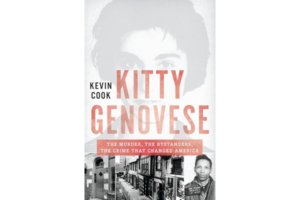Kitty Genovese
Kevin Cook's book clears up the misconceptions surrounding the famous New York City murder case.

Kitty Genovese,
by Kevin Cook,
Norton, W.W. & Company,
256 pp.
Only a handful of murders in 20th-century America can be said to have become national sensations: Leopold and Loeb. O.J. The Lindbergh Baby. Ted Bundy’s spree. Kitty Genovese.
Okay, that last name might not be as familiar as the others. But the details of the crime are almost certainly known to you. In New York City in 1964, the 29-year-old Genovese was stabbed to death in three separate attacks as 38 neighbors watched and declined to get involved.
At least, that is commonly reported version of the story. But Kevin Cook explains in his new book Kitty Genovese why this simplified version of the story is not the true one.
Cook, a freelance journalist, has accessed for his book the detective’s reports of their preliminary interviews with Genovese’s neighbors. He found that, rather than including 38 eyewitnesses, the police log contained 38 entries.
Writes Cook: “It was a roundup of interviews with many of Kitty’s neighbors, not a definitive accounting of anything.” Far fewer eyewitnesses actually existed, and those that did were generally fearful of getting involved, rather than indifferent to the woman. The popular figure of 38 resulted from a clerical error provided to the police chief, who passed it along to the New York Times reporter who made the case famous.
It was a consequential mistake. The murder shocked Americans, who were horrified and baffled that so many onlookers refrained from intervening to assist the woman. The idea of 38 people so self-obsessed and alienated from their neighbors reflected the anxieties of many citizens, who saw rising crime, feared the Civil Rights Movement, and felt alone in an urbanized America.
CBS’s Mike Wallace narrated a segment on “The Apathetic Americans.” The murder spurred officials to create the 911 emergency-phone system. States created Good Samaritan laws. Victim-compensation laws, witness-assistance programs, neighborhood watch groups – the list of public policy changes that resulted from reaction to the case is extraordinary.
Equally more remarkable has been the lasting influence the murder – particularly the false figure reported – has had in academia. One professor tells Cook that the murder is “the most-cited incident in social psychology literature until the September 11 attacks.”
Cook manages to maintain an impressive level of tension in a book about a half-century old case about which everyone thinks they know the outcome. He assumes, surely correctly, that while many readers may have heard of the case, they don’t recall the specifics aside from the number of eyewitnesses. So he treats Genovese’s murder like something of a mystery – we may know that she was killed, but not why. And who was Kitty Genovese, anyway?
She was, in fact, a lesbian, a fact that likely would have drastically affected the public’s response to the crime, had it been reported at the time. The police chief wrote in his 1974 memoir that “it’s also our experience that homosexual romances produce more jealousy by far than ‘straight’ romances.” Given such prejudices a full decade after the crime, Genovese’s partner publicly played along with the fiction that the two were just roommates. Indeed, her reminisces are the most moving in the book, as she recalls the woman she lost so long ago.
“After Kitty died I went from thing to thing,” she tells Cook. “I’d lost my faith in people – in everything, really.”
Equally compelling is the killer. It is a testament to "Kitty Genovese" that the author avoids unnecessary judgment in favor of letting Winston Moseley (there’s no spoiler here – he’s named on the book jacket as the culprit) portray himself as a sociopath with his own chilling words. From the court transcript that Cook quotes:
“Did you think back about killing Kitty Genovese after doing it? Did you feel sorry for her?”
“No.”
“Do you feel sorry for her today?”
“No.”
Somehow, Moseley managed to escape from prison. What he did after prison was as empathy-free as what he did before.
And then there were those infamous bystanders, which actually numbered five or six. One of them is a manipulative coward who functions as a fascinating character in his own right. Another seems like something of a sociopath himself. He is the lone eyewitness who seems to genuinely warrant the decades of scrutiny and questioning that have surrounded the murder.
But he was only one man. There were not 38 of him.
Jordan Michael Smith is a Monitor contributor.

